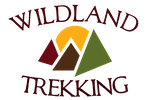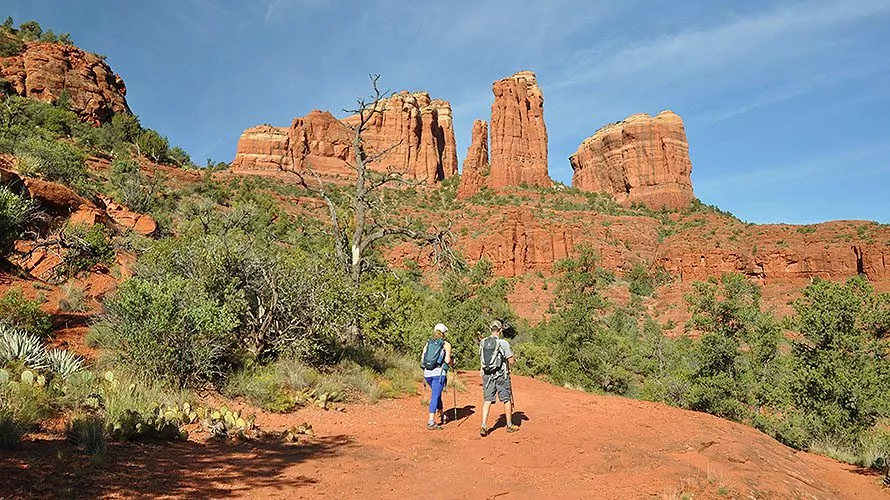
Red Rock Basecamp Tour
Sedona, AZ
Description
Our Red Rock Basecamp tour is an opportunity to hike the best of Sedona’s wild backcountry and have an all around outdoor experience, while still enjoying front country comforts like showers, swimming pools, cold drinks and elaborate meals. On this tour let us take care of everything, so you can focus 100% on exploring and enjoying the magical high desert world around Sedona. Enjoy wonderful outdoor cuisine, comfortable camping, iconic Sedona landscapes, other-worldly rock formations, amazing history, and must-do Sedona hikes!
In the mornings we’ll embark on a mix of carefully selected day hikes that acquaint you with the unique and amazing features of Sedona’s Red Rock Country: towering buttes, cliffs and other rock formations; deep canyons and rainbows of colored sandstone; spring-fed creeks; fascinating cultural and natural history; endless views and more! In the afternoons we’ll return to our camp next to Oak Creek to relax and read a book on the beach, enjoy a dip in our campground’s swimming pool, go for walks along the creek, or drive into Sedona to visit museums, shops and art galleries. At night we’ll feast on wonderful, outdoor meals and relax around a blazing campfire.
Wildland Trekking is a permitee of the USFS, Red Rock Ranger District.
| Trip Type: Camping Hiking Tour |
Difficulty Level:
|
|
Solitude Level:
|
Group Size: 2-6 Guests |
| Trip Length: 4 Days | Distance: 27 MI / 43 KM |
|
Hiking Distances: 6-10 mi |
Backpack Weight: 8-12 lbs |
|
Terrain: Moderately Rugged |
Max Daily Elev. ↑↓: Up to 2250 ft |
|
Heights Exposure: Moderate |
DIFFICULTY LEVEL 2
Scale of 1-5. 1 is least difficult; 5 is most difficult
Sedona trips follow well traveled and built trails, but the nature of the landscape lends itself to sections of moderate heights exposure and consistent walking on rocky and sandy terrain. This trip has long hiking distances but with generally moderate elevation gains and light backpack weights. It is between a level 2 and 3 difficulty tour, tending slightly toward level 2.
Please Note: Terrain, Elevation Gain and Heights Exposure ratings reflect the section or day of the trip with the maximum difficulty of each. Much of the trip is at easier levels. See the trip itinerary for more detailed information.
PHYSICAL DEMANDS OF THIS TRIP
- Hiking uphill or downhill with a 8-12 lb backpack for 6-8 hours
- Maintaining balance and footing on moderately rugged terrain
- Hiking with moderate heights exposure
SOLITUDE LEVEL 2
1 least solitude, 5 most solitude
We rate this Sedona hike a solitude 2. You can expect as much as an hour of solitude at a time while hiking.
Learn More about our Rating SystemWHAT’S INCLUDED
- Roomy tent, supportive sleeping pad, and cozy sleeping bag
- Use of trekking poles
- All meals are included from breakfast the first day through lunch on the last day
- A professional, knowledgeable, certified Sedona hiking guide
- Transportation for the duration of the tour, beginning and ending in Sedona
- National Forest recreation passes
- Emergency equipment including a company-issued first-aid kit and communication device (InReach Explorer or satellite phone)
WHAT’S NOT INCLUDED
- Clothes, raingear, and footwear (see recommendations)
- Sunscreen, toiletries and personal items
- Water bottles and a headlamp or flashlight
- Guide gratuity (industry recommendation is 10-20% of trip cost)
Day 1
- Hiking Mileage: 8.6 miles
- 1-way Elevation Change: 1198 feet
- Campground: Lo Lo Mai Campground
The first day of this Sedona hiking tour we experience one of Sedona’s gem hikes as we walk back in time on old wagon roads (now trails) to a red rock saddle that offers incredible views. The trail we hike, Hangover Trail, named for the overhanging rock that shelters part of the route from the sun, is a Sedona must-do. It involves exhilarating steps on pure sandstone up Schnebly Hill for vistas and panoramic views of the canyons below. This is a great hike to hear the history and story of T.C. Schnebly and his wife Sedona, for whom the town is named after. We’ll take our time returning to the trailhead to enjoy the downhill hiking and soak up the views.
After our hike we’ll head to our campground and set up camp. We’ll get “moved in” to our tents and enjoy some time to relax, swim, shower or explore Oak Creek before a fantastic dinner and campfire.
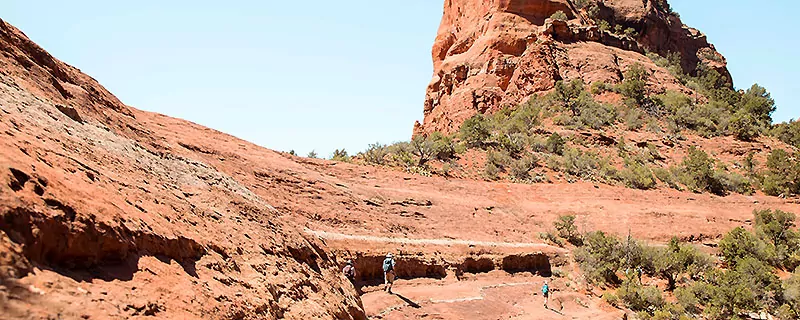
Day 2
- Hiking Mileage: 8.8 miles
- 1-way Elevation Change: 2250 feet
- Campground: Lo Lo Mai Campground
Today we’ll head north to conquer Sedona’s highest peak at 7,122 feet.
On the first few steps of this hike we’re immediately transported to an entirely new character of landscape – the ecosystem is lush, with tall, deciduous and coniferous trees. Towering red and white sandstone spires protrude from the mountainside and provide stunning views as we ascend to the summit of this glorious mountain.
On the summit we’re rewarded with arguably one of the best views the Sedona area can offer – a panorama of the beautiful Red Rocks surrounding us and Oak Creek Canyon below us! We’ll enjoy a wonderful, relaxing picnic lunch with endless Sedona views as our backdrop before hiking back to our trailhead.
We’ll shuttle back to our campground, relax for an hour or two, and then enjoy another outstanding outdoor dinner.
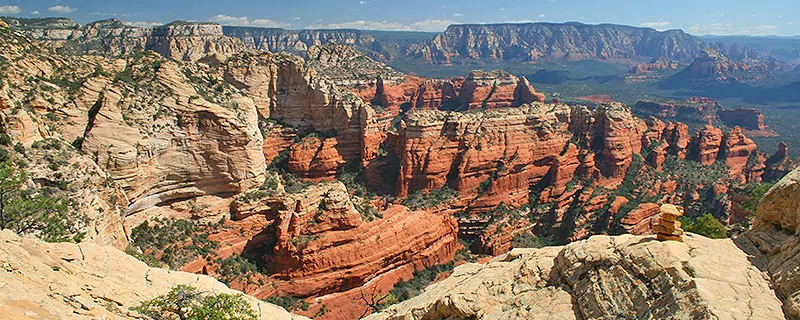
Day 3
- Hiking Mileage: 7.5 miles
- 1-way Elevation Change: 500 feet
- Campground: Lo Lo Mai Campground
Today is a more relaxing but iconic Sedona hike. We’ll walk 7.5 miles on one of Sedona’s most scenic hiking routes. We begin near Courthouse Butte and Bell Rock, two of Sedona’s most prominent and beautiful landmarks, and quickly climb several hundred feet into layered shelves of red rock sandstone. We’ll stop to appreciate and learn about all the different types and uses of desert plants in the area. Half-way into our hike we’ll reach Cathedral Rock, a stunning, nearly 1,000 foot tall sandstone monolith.
We’ll rest in the shade of cottonwood trees lining the banks of Oak Creek, along the northwest side of Cathedral Rock. Your guide will prepare a tasty lunch and share some of the native and indigenous history of the area – this very spot was once a fertile hunting ground. Nearby, petroglyphs hidden behind oak brush and manzanita tell the story of how deer were once hunted along the banks of this perennial stream.
After lunch we’ll complete our hike among the towering cliffs, sheer pinnacles and pristine canyons of Sedona. We’ll shuttle back to our campground, relax for an hour or two, and then enjoy another outstanding outdoor dinner.
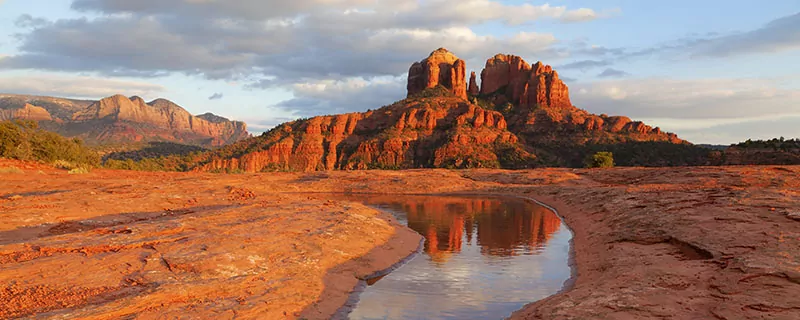
Day 4
- Hiking Mileage: 6-10 miles
- 1-way Elevation Change: 400-1400 feet
- Campground: Lo Lo Mai Campground
Today is a perfect treat to top off our amazing 4 days of hiking! We finish this trip with a creek hike that brings us to a beautiful high desert oasis (with great swimming)! The hike is moderate and follows close to the creek the whole way until we reach our swimming destination about 3.5 miles in.
We will enjoy a nice lunch creekside and take full advantange of the shady trees. We will have the option to continue up into the Mogollon Rim 1,100 feet above Wet Beaver Creek or take the nice stroll back to the trailhead. This is an amazing hike and opportunity to see an entirely different side of the Red Rock District!
After the hike, we will travel back into Sedona proper and say our goodbyes after an amazing 4 days.
Please Note: We always do everything in our power to follow the set itinerary, however it can change occasionally based on temporary access restrictions, weather, lodging/campground availability, guest ability/injury, natural events like fires and flooding, and other potential causes. Normal terms and conditions apply to trips with itinerary changes.
PACKING LISTS

IMPORTANCE OF BEING PREPARED
Your safety and enjoyment will depend on your level of preparedness. It is your responsibility to arrive with the items listed below. Our Gear Guide is a resource to find more information about these items and links to online options. If you have additional questions about what to pack, please ask your guide during the pre-trip contact (~10 days prior to the trip start date) or call our Adventure Consultants 7 days a week at 928-223-HIKE (4453).
STANDARD CLOTHING CHECKLIST
The following items are required for your trip unless otherwise noted. When packing, think layered clothing systems that work together and can be easily added or removed.
(GG) = Gear Guide: see for more info and links to product options
- Hiking Boots/Shoes – mid-weight, lug-soled, and ideally well broken in (Boots GG – Shoes GG)
(Note: buy your boots/shoes 1/2 size to 1 size larger than your street shoes to allow for feet swelling and thicker socks) - Secondary Footwear – supportive, lightweight, well-drained shoe or sport sandal for creek crossings and/or for camp comfort (Camp Shoes GG)
- Hiking Socks – one pair for every two days of your trip, plus an extra pair to sleep in. Hiking-specific padded socks, no cotton please! (Socks GG)
(Note: wearing thin liner socks under your hiking socks can help prevent blisters) - Sun Hat – wide brimmed hat or baseball cap/bandana combo (Sun Hats GG)
- Cotton T-shirts – at least 2 short or long sleeve shirts, these retain moisture and will help to cool the body down in arid desert environments
- Hiking Shirts – non-cotton, breathable short sleeve and/or long sleeve shirts (Shirts GG – Sun Hoodies GG)
(Note: long sleeve shirts provide better sun protection) - Warm Top – mid-weight sweater or pullover of wicking material such as merino wool, fleece or polypropylene (Mid Layer GG)
- Hiking Pants & Shorts – nylon pants AND shorts, zip-offs or leggings (Pants GG – Shorts GG)
- Rain Gear – waterproof jacket, breathable fabric such as Gore-Tex® or coated nylon. (Rain Coats GG)
- Casual Clothing & Footwear – comfortable clothes and shoes for evenings off the trail
- Personal Luggage – small duffel bag, suitcase or backpack – for extra hiking clothes and casual clothes
ADDITIONAL CLOTHING (OCTOBER – APRIL)
- Warm Hat & Gloves – lightweight beanie and light-to-mid weight fleece or wool gloves (GG)
- Mid Layer Insulating Jacket – down-fill or synthetic-fill insulated “puffy” jacket or warm, heavy-weight fleece jacket (Mid Layers GG)
- Base Layer/Long Underwear – 1 pair of wicking tops and bottoms that are lightweight to midweight, synthetic wicking materials such as polyester, polypropylene, merino wool…etc. (Base Layer GG)
- Rain Pants – waterproof pants, breathable fabric such as Gore-Tex® or coated nylon. Look for side zippers that will allow you to pull them over your boots. (Rain Pants GG)
Important Note: Please, no cotton hiking clothes with the exception of the “Cotton T-shirts” section above. Feel free to call us if you have any questions or you can reference our Gear Guide.
GEAR CHECKLIST
- Hydration System – 3+ liters capacity, either water bottles or bladder/hose system and an additional water bottle (Hydration Bladders GG)
(Note: We recommend always having a bottle with 1 liter of capacity as a back-up in case of a hydration system failure and to use while in camp) - Headlamp – preferably with an L.E.D. bulb that works with AA or AAA batteries (Headlamps GG)
(Note: always test your headlamp before trips, travel/pack without batteries in device, and for longer trips (4+ days) consider a spare bulb and 1 set of spare batteries) - Sunglasses, Sunscreen, Lip Balm
- 2 Bandanas
- Contact Lenses and Glasses – if you wear contact lenses, please also bring a pair of glasses – your contacts are likely to become dirty and may be difficult to clean
- Prescription Medication – please inform your trip leader of any medications you are taking
- 1-2 Face Masks (Recommended but Optional)
- Toiletries – small amounts, travel sizes and/or just what you need for the trip (important that they are small!)
- Money – for any shopping you would like to do and for consideration of tipping your guide
(Note: tipping is optional but appreciated, industry recommendation is 10-20% of your trip cost based upon the quality of your experience)
OPTIONAL ITEMS
- Personal Trekking Poles – as a Wildland guest, you can enjoy a 20% discount off Leki trekking poles (reservation number required.) Click here for discount. Trekking poles are provided for guests who do not bring their own. (Trekking Poles GG)
- Swimsuit – only if swimming is an option on your trip, some guests prefer to swim in quick drying hiking clothes, sports bra, etc…
- Stuff Sacks – various sizes for better organization of clothing & gear, and/or to help create a camp pillow, etc.
(Note: A lightweight waterproof stuff sack can be extremely useful in wet conditions) - Support Braces – consider bringing any joint braces that may be currently needed or from past injuries (i.e. knee, ankle, elbow, etc…)
- Camp Reading Material – lightweight paperback book, magazine or small notebook/pen for journaling
- Cell Phone or Camera
- Spare Batteries – for camera, headlamp or other electronics
- Solar Charger or Charging Bank – small, lightweight devices to recharge electronics
- Vitamins & Supplements
- Quick Dry Towel – lightweight, compressible and packable – bandanas also work
TRAVEL, TRANSPORTATION, MEETING & LODGING

VIRTUAL PRE-TRIP ORIENTATION
Your pre-trip orientation meeting will be done virtually on a conference call with your guide and the other guests at 5:00 PM the evening before your trip starts. Your guide will go through the packing list, communicate the first day’s logistics, and answer any last minute questions you have. Your guide will give you the phone number for this meeting approximately 10 days before the trip start date.
PICK UP IN SEDONA
Early on the morning of Day 1 your guide will pick you up from your accommodations in Sedona, Arizona; Your guide will coordinate the time of pick up during the pre-trip orientation conference call.
TRIP CONCLUSION
This trip will conclude at approximately 5:00 PM on the last day.
ARRIVAL & DEPARTURE DATES
Travel to and from the trip starting point is not included in the cost of our trips. Please plan on arriving in time for the orientation meeting the day before the trip leaves and departing the day after getting back from the field.
GATEWAY CITIES:
Phoenix, Flagstaff or Las Vegas, NV
All Sedona trips begin and end in Sedona, Arizona. Your best gateway cities are Phoenix and Las Vegas.
Coming from Phoenix
The most popular option is to fly into Phoenix and rent a car or take a shuttle to Sedona with Groome Transportation. The shuttle is your cheapest option. It is a 1 hour and 45 minute drive from Phoenix to Sedona.
Coming from Las Vegas
There is no shuttle service from Las Vegas to Sedona, so if you’re flying into Las Vegas the only way to reach Sedona is via rental car.
SHUTTLE FROM PHOENIX TO SEDONA
Arizona Executive Transport: 1-602-475-1125
STORAGE OF PERSONAL ITEMS & VEHICLES
We recommend checking with your pre- and post-trip hotel about luggage and vehicle storage. If they do not offer these services, please let us know and we’ll work with you on solutions.
Recommended PRE & POST-TRIP LODGING
Inn Above Oak Creek
Website / Phone: 928-282-7896
Best Western Arroyo Roble
Website / Phone: 928-282-4001
TRIP INSURANCE
We strongly recommend purchasing trip insurance. We designed our terms and conditions with trip insurance in mind. When you register for a trip, your spot is no longer available to other guests. Therefore, if you discover inside of 30 days (prior to your trip departure date) that you are unable to travel, no refund is available. With trip insurance, not only is your payment to Wildland covered, but your flights, hotels and other travel costs can also be insured.
Read more about our trip insurance recommendations.
CHECK THE WEATHER FORECAST FOR YOUR HIKE
We recommend using NOAA’s website (www.weather.gov) for the most accurate 5-day weather forecasts. Click here to see a Sedona forecast.

PACK WEIGHT AND CONTENTS
You will be hiking with a light day pack that we provide. You’re also welcome to bring your own. The contents will be what you need for the day – rain gear, an extra layer or two, snacks, water, sunscreen…etc.
ESTIMATED PACK WEIGHT: 8-12 POUNDS
Essential Eligibility Criteria
Essential Eligibility Criteria (“EEC”) have been specifically identified to help you understand the skills and abilities necessary to participate on each Wildland trip, and they apply uniformly to all potential trip participants, irrespective of the presence or absence of any disability.
Once you identify a trip in which you may be interested, please carefully review the EEC and itinerary details. If after reviewing the EEC that apply to your desired trip, you determine you need an accommodation in order to meet the EEC, please contact us prior to registering to discuss your requested accommodation.
The EEC exist for your own safety and the safety and enjoyment of all participants. If you are unable to meet the EEC for the trip, with or without an accommodation, you are not eligible for that trip. If you register and arrive for a trip for which you do not meet the EEC, you will be disqualified from participation on the trip and will be dismissed or evacuated from the trip without a refund.
TRAINING TIPS

The better shape you’re in the more fun you’ll have! We recommend very strongly that you train for your trip.
TRAINING BY HIKING
If you have access to hiking trails in hilly or mountainous terrain, this is the ideal way to train. If not, we recommend using the Stairmaster machine (with rotating stairs like an escalator) or actually training on stairs. Nothing prepares you for a trip better than the activity itself!
Train at least 3 days a week. Start with short hikes or workouts (1-hour in length) with a light daypack. From week to week build the length and intensity of your hikes/workouts and gradually increase your pack weight until you’re comfortably able to hike 6-8 hours a day carrying the weight you’ll have on your trip. It’s best to begin your training regimen at least 12 weeks prior to your trip. Also be sure to use the boots you’ll have on your trip to break them in.
Following is how a program may look:
| First Week | Work Up To |
| Tuesday: 1-hour hike/workout with daypack Thursday: 1-hour hike/workout with daypack Sunday: 2-hour hike/workout with daypack |
Monday: 2-3 hour hike/workout with daypack Wednesday: 2-3 hour hike/workout with daypack Thursday: 2-3-hour hike/workout with daypack Sunday: 7-hour hike with the weight you’ll have on your trip |
SUPPLEMENTAL TRAINING IDEAS
There are many other activities that are easily incorporated into your daily life to build your overall fitness. Cross training is important to strengthen opposing muscle groups and it helps to avoid over-use injuries. Supplemental training ideas include:
- Bike to work or when running errands.
- Gym activities including step aerobics, treadmill, bicycling, or elliptical trainers to name a few. A modest weight training program focusing on the muscles that support the ankles, knees, back, and shoulders is also beneficial.
- Swimming is a great way to build endurance and cardiovascular fitness and is easy on the joints.
- Walk to work instead of driving. Run your errands by walking and carry your groceries home in a backpack.
- Yoga and/or Pilates classes can build strength throughout your body while also improving your flexibility.
- Intramural sports
- Jogging is another option, however if you are not a regular runner it can easily lead to injuries that backpacking may then exacerbate. Undertake a jogging routine with care.
FLEXIBILITY AND HYDRATION
Flexibility is an important part of training. Remember to stretch before and after your workouts. For the two weeks leading up to your trip cut your workouts in half to avoid arriving fatigued. Also for a 72-hour period before your trip commences, ensure that you are consuming sufficient amounts of sodium and fluids. Doctors agree that hikers increase the likelihood of experiencing problems if they are sodium depleted (e.g., follow a low sodium diet) or are dehydrated (due to travel or using diuretics such as coffee or alcohol).
Important note: Always consult with your physician before commencing with a workout program.
GROUP TRAVEL

If you’re joining one of our scheduled trekking tours you’ll be hiking with fellow outdoor enthusiasts. Please carefully examine the trip materials and difficulty level prior to registering to select a trip that matches your ability level. If you need assistance selecting the right trip we are more than happy to help.
We make every effort to accurately set expectations and effectively screen guests, however it is inevitable on some trips there will be a discrepancy in fitness levels. Consider that the trip may be a once in a lifetime opportunity for your fellow travelers and it is important to respect each guest’s individual condition, needs and desires.
Finally, guided groups are required by land management agencies to stay together on the trail. Hiking together can require patience and flexibility. If hiking at a very specific pace is extremely important to you, you may want to consider booking a private trip.
 TIPPING YOUR GUIDE
TIPPING YOUR GUIDE
Tipping your guide is greatly appreciated! Wildland guides, and outdoor/backcountry guides in general, do much more than lead guests down the trail. Although supported by amazing in-town staff, they often work independently in the field due to permit and logistical constraints. The guide is responsible for the group’s safety, menu planning (including dietary restrictions), cooking for the group, prepping and taking care of the gear, handling livestock (on stock-supported trips), driving, complying with government regulations, ensuring guest satisfaction, and generally making sure the tour runs smoothly. They wear many hats and are extraordinary at what they do!
The industry standard tip amount for hiking and backpacking guides is between 10% and 20% of the tour cost per person, depending on your level of satisfaction. If you have any questions about tipping, feel free to call us 7 days a week at 800-715-HIKE (4453)!

GUIDE SHIFTS
Guides are required to take 8 hours off each 24-hour period to sleep, recuperate, take personal/down time…etc. In addition, as part of the 8 hours off they must sleep/rest or be in their tents/rooms uninterrupted for a minimum of 5 hours each night. We ask guests to respect these requirements and to not interrupt guides’ off time and sleep time unless there is a true emergency.

Thank You! The Wildland Trekking Company is dedicated to delivering an exceptional travel experience that exceeds your every expectation. We believe travel and adventure are two of life’s great joys and take seriously our role in helping you create a trip of lasting memories. In addition to our role as your travel partner and outfitter we are dedicated to the promotion of stewardship and conservation in the regions we visit. One of our commitments is to use Wildland as a tool toward long-term sustainability of the Earth’s environment and its communities. If there is anything we can do to further inform or help you prepare for your upcoming adventure please do not hesitate to contact us. Thanks for the opportunity to serve you and we look forward to seeing you soon!

800-715-HIKE (4453)
Feel free to call us for more info – we’re here 7 days a week!

